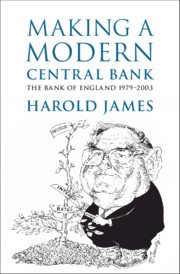Book contents
- Making a Modern Central Bank
- Studies in Macroeconomic History
- Making a Modern Central Bank
- Copyright page
- Dedication
- Contents
- Figures
- Tables
- Acknowledgements
- Abbreviations
- 1 Introductory
- 2 Foreign Fetters
- 3 The Performance of the UK Economy
- 4 The Inexplicable in Pursuit of the Uncontrollable
- 5 ‘A Good Deal of Advice’
- 6 The Long Shadow of the Deutschemark
- 7 Hong Kong
- 8 Shaved Eyebrows
- 9 Tunnelling Deep
- 10 Great Leap in the Dark
- 11 The Spine Theory and Its Collapse
- 12 ‘You Can’t Be In and Out at the Same Time’:
- 13 Horses for Courses
- 14 Failure of Internal Communication
- 15 The New Bank
- 16 Epilogue
- Book part
- Notes
- Bibliography
- Index
6 - The Long Shadow of the Deutschemark
The Exchange Rate Alternative
Published online by Cambridge University Press: 18 September 2020
- Making a Modern Central Bank
- Studies in Macroeconomic History
- Making a Modern Central Bank
- Copyright page
- Dedication
- Contents
- Figures
- Tables
- Acknowledgements
- Abbreviations
- 1 Introductory
- 2 Foreign Fetters
- 3 The Performance of the UK Economy
- 4 The Inexplicable in Pursuit of the Uncontrollable
- 5 ‘A Good Deal of Advice’
- 6 The Long Shadow of the Deutschemark
- 7 Hong Kong
- 8 Shaved Eyebrows
- 9 Tunnelling Deep
- 10 Great Leap in the Dark
- 11 The Spine Theory and Its Collapse
- 12 ‘You Can’t Be In and Out at the Same Time’:
- 13 Horses for Courses
- 14 Failure of Internal Communication
- 15 The New Bank
- 16 Epilogue
- Book part
- Notes
- Bibliography
- Index
Summary
After 1985, the UK first assigned a ‘greater importance‘ to exchange rate objectives, without specifying any rule; then followed between early 1987 and March 1988, an unannounced policy of linking the pound to the deutschemark at the rate of 3 DM/£ was pursued. That policy, undertaken without the knowledge of the Prime Minister, eventually led to a sharp political conflict between Thatcher and Lawson. Subsequently, the exchange target was abandoned. All three phases of the new exchange rate regime were conceptually incoherent, and the lack of monetary control in the second half of the 1980s eventually produced not only rapid growth (that looked like a policy success and was termed the ‘Lawson boom‘) but also a new upsurge of inflation that increasingly concerned the Bank. Eddie George emerged not only as a key architect of Bank strategy but also as a favoured interlocutor of Margaret Thatcher. A background to the policy debates was the increased attraction, to the Treasury and to some figures in the Bank, of the European Monetary System as a way of securing the deutschemark as an anchor, and international coordination on exchange rates became more central to monetary policy management; Thatcher and George were critical of that vision.
Keywords
- Type
- Chapter
- Information
- Making a Modern Central BankThe Bank of England 1979–2003, pp. 147 - 188Publisher: Cambridge University PressPrint publication year: 2020

